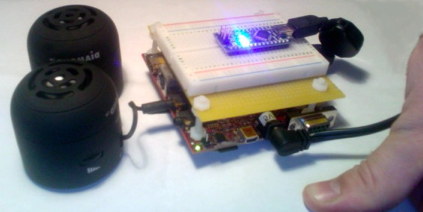How To Get Satellite CCRMA
by Edgar Berdahl, July 2011 and updated March 2013
1. Get The Parts
See this link for a list of the parts.
2. Burn Image to the SD Card
Be very careful when carrying out this procedure! If you choose the wrong disk or partition, you could easily erase everything on it!
- First download the appropriate Satellite CCRMA SDHC card image from the main page.
- Before uncompressing the image file (it it is compressed), check the following. If you have a mac, then run
md5 [name of the downloaded file]
or if you have Linux, then run
md5sum [name of the downloaded file]
to ensure that this checksum matches the one on the main page. Otherwise, try downloading the compressed image again.
- Uncompress the image.
- Then run the df command in the Terminal and look at the output. For example, I get
OSX-Freshinstall:~ eberdahl$ df
Filesystem 512-blocks Used Available Capacity iused ifree %iused Mounted on
/dev/disk0s2 486717952 448570928 37635024 93% 56135364 4704378 92% /
devfs 394 394 0 100% 682 0 100% /dev
map -hosts 0 0 0 100% 0 0 100% /net
map auto_home 0 0 0 100% 0 0 100% /home
- Connect the blank (micro) SD card to your Mac by plugging it in directly to a camera SD card reader or use a USB micro SDHC reader/writer.
- Run the df command again in the Terminal to determine that the SD card (in this case named Untitled) corresponds to the partition /dev/disk2s1 on the disk /dev/disk2 (or for you, it might show up as /dev/disk3s1 and /dev/disk3 or /dev/disk4s1 and /dev/disk4, etc.) Usually it shows up on the last line:
OSX-Freshinstall:~ eberdahl$ df
Filesystem 512-blocks Used Available Capacity iused ifree %iused Mounted on
/dev/disk0s2 486717952 448570928 37635024 93% 56135364 4704378 92% /
devfs 394 394 0 100% 682 0 100% /dev
map -hosts 0 0 0 100% 0 0 100% /net
map auto_home 0 0 0 100% 0 0 100% /home
/dev/disk2s1 114576 44992 69584 40% 512 0 100% /Volumes/Untitled
- Unmount the partition by executing
diskutil unmountDisk /dev/disk2s1
or similar.
- Write the image to the entire disk using the following
dd if=SatelliteCCRMA-xMRevC_Maverick.dd of=/dev/disk2
where you substitute the appropriate image and disk names. This will take a while. Once finished, the SD card will generally only be fully readable by Linux computers.
<Note from Wendy, July 2012>
If you want to see how far along in the process you are, you can open another terminal window, and type
killall -INFO dd in Mac OS X, or
killall -USR1 dd in Linux. Read the results in the terminal carefully. If the error is only that it was unable to write the last few blocks, that may be ok. We have padded the image with zeros at the end, so theoretically it shouldn't matter so much if some of the zeros at the end are missing.
For instance, when the procedure works for me, I see that almost all of the records are copied
dd if=SatelliteCCRMA-xMRevC_Maverick.dd of=/dev/disk3
7457+0 records in
7456+1 records out
7818186752 bytes transferred in 6604.225241 secs (1183816 bytes/sec)
Tip for verifying the image: Attach an HDMI monitor to the kit so you can watch the output as it is trying to boot the image.
If you have any further difficulties: Try again, use e.g. of=/dev/rdisk3 instead, and/or try including the option bs=1m. This changes the block size of each write. No matter what, using a high-quality (micro) SDHC card can save you a lot of trouble later! For instance, we use the Kingston micro SDHC cards (minimum class 4, class 10 is better) that come with the Beagle Board xM.
3. Put Them All Together
Plug everything in, and you should be ready to go. Here it is with some speakers.
